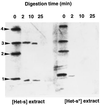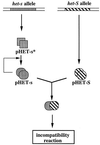The protein product of the het-s heterokaryon incompatibility gene of the fungus Podospora anserina behaves as a prion analog
- PMID: 9275200
- PMCID: PMC23266
- DOI: 10.1073/pnas.94.18.9773
The protein product of the het-s heterokaryon incompatibility gene of the fungus Podospora anserina behaves as a prion analog
Abstract
The het-s locus of Podospora anserina is a heterokaryon incompatibility locus. The coexpression of the antagonistic het-s and het-S alleles triggers a lethal reaction that prevents the formation of viable heterokaryons. Strains that contain the het-s allele can display two different phenotypes, [Het-s] or [Het-s*], according to their reactivity in incompatibility. The detection in these phenotypically distinct strains of a protein expressed from the het-s gene indicates that the difference in reactivity depends on a posttranslational difference between two forms of the polypeptide encoded by the het-s gene. This posttranslational modification does not affect the electrophoretic mobility of the protein in SDS/PAGE. Several results suggest a similarity of behavior between the protein encoded by the het-s gene and prions. The [Het-s] character can propagate in [Het-s*] strains as an infectious agent, producing a [Het-s*] --> [Het-s] transition, independently of protein synthesis. Expression of the [Het-s] character requires a functional het-s gene. The protein present in [Het-s] strains is more resistant to proteinase K than that present in [Het-s*] mycelium. Furthermore, overexpression of the het-s gene increases the frequency of the transition from [Het-s*] to [Het-s]. We propose that this transition is the consequence of a self-propagating conformational modification of the protein mediated by the formation of complexes between the two different forms of the polypeptide.
Figures




References
Publication types
MeSH terms
Substances
LinkOut - more resources
Full Text Sources
Other Literature Sources

